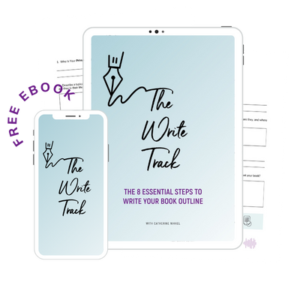I wholeheartedly believe everyone has a story to tell. And you’re here because I believe you want to learn how to write a book about your life.
As human beings, it is in our nature to seek out connection.
This is one of the main reasons most people will read stories – to learn, grow, laugh, cry, and feel something.
Sometimes the simple act of telling your personal story can change someone’s life or inspire them to tell their own life story. Imagine the ripple effect!
If you are here reading this, it means some part of you (even a tiny one) wants to write a book about your own life or maybe another person’s life, and I’m so excited for you.
Yes, it will take hard work, but it doesn’t have to be daunting.
(especially with a book outline template that you can grab absolutely free here if you haven’t already)
In this post, I will answer all your burning questions about how to write a book about your life and give you some valuable tips to get started.
Memoir vs. Autobiographical Writing
Let’s start by exploring the different ways you can write a book about your life.
In the narrative non-fiction world, you can write two types of books that tell the story of a person’s life, both of which are shared in the first person point of view (POV) if you are the author. I should also note that these are a true story and can be as simplistic as what everyday life looks like for you. Or, you may choose to share your entire life story. Whichever path you head towards, wanting to write a book about your life is admirable.
So, let’s do our best to not create a daunting task for you and dive into the parameters of what one might call life writing.
What is a Memoir?
A great memoir focuses on a specific period of time or an underlying theme of critical events throughout your life. It often contains short stories that retell moments in your life.
For example, you may write a memoir about your high school years (i.e., a period of time) or the experiences that have shaped you as a writer (i.e., themed).
Some great examples of very well-known memoirs include:
- I Know Why the Caged Bird Sings by Maya Angelou – a retelling of painful childhood memories coupled with moments of kindness and her journey of self-love.
- The Story of My Life by Helen Keller – the story of Helen’s journey to breakthrough the world of communication and triumph over deafness and blindness
- Becoming by Michelle Obama – a compilation of life stories and Michelle’s journey to and time in the White House
- Bossypants by Tina Fey – a humourous retelling of Tina’s childhood, the start of her comedy career and her rise to stardom.
At the time of writing this, I am just wrapping up the memoir What We Carry by Maya Shanbhag Lang. This author was not known to me; however, Audible, Indigo and Amazon sure have their processes figured out that recommend books based on books I’ve already purchased (well played!)
What is an Autobiography?
On the other hand, an autobiography is more comprehensive in that it tells your whole life story from the beginning to the present day.
Autobiographies are sometimes written by the person who has lived the experiences, and other times are written by someone else in memory of an individual after their passing (e.g., Diary of Anne Frank).
Some well-known individuals that have written autobiographies of their life’s story include Mahatma Gandhi (lawyer and political ethicist), Agatha Christie (best-selling fiction author) and Andre Agassi (tennis player).
Though they lived such different lives, each had a unique story worth telling.
Other famous autobiographies you might be familiar with are Long Walk to Freedom by Nelson Mandela, I am Malala: The Girl Who Stood Up for Education and was Shot by the Taliban by Malala Yousafzai, The Autobiography of Malcolm X by Malcolm X, or Cash by Johnny Cash.
Writing a memoir or an autobiography is entirely up to you; however, if you are a new writer, I suggest starting with a memoir. Memoirs are often easier to read and write, allowing you to leverage your theme to draw in your audience. In addition, they will enable you to focus on one specific event or a short series of events — and, more often than not, the events that occurred that have you leaning toward wanting to write your story in the first place.
Think about a time when you shared a piece of your life with someone, and they responded, ‘you should write a book!’. One could safely assume that the story you were sharing impacted the listener, a story that inspired them to either know more or take some form of action.
Wanting to know how to write a story about your life can feel overwhelming, but it doesn’t have to be. For example, consider starting with that specific story you shared with said person.
I have a free book outline, ‘The Write Track,’ that you should start with (you can find it here). Once you start working with that particular story, decide whether to keep it more memoir-focused or expand it into a brilliant autobiography.
And remember, you probably have several books inside of you — this is helpful to keep in mind when starting to write a book about your life so that you don’t feel a need to jam everything into one unless it aligns with your purpose and will meet the goal you have set out for your story.
Start by Reflecting
If you want to write a book about your life, you will need LOTS of content. You will also need to feel confident about your writing (here are some tips for improving your writing skills).
Reflection Exercise:
- Start by making a list of your life experiences.
- Organize all the crucial moments you listed in chronological order.
- As you continue to reflect and remember, fill in the gaps, adding other details and personal experiences as needed.
- Notice if any key themes emerge and highlight them for future reference.
- Once you feel your timeline is sufficiently completed, or if there is a particular memory or life event that calls to you, choose specific events and free write about them.
Trust your intuition and write as much as possible. It is best to sit down for a few hours at a time to get into a good writing groove.
Pro Tip: Don’t worry about keeping things in chronological order when you write. Just write, and the structure and finessing can happen later.
Time-saving Tip:
This is your very first draft, so don’t spend too much time trying to express everything perfectly. But, most importantly, you get all the details out of your mind and onto your paper/computer. Document the important moments, the real people and allow yourself to just start writing.
Even if you write more stories than you need for your book, this is a great exercise, and you never know when you will use what you wrote in the future. Some people refer to this as a brain dump. One of the ways my book coaching clients find beneficial is using voice memos to record their thoughts, stories and ideas. These can be quickly and inexpensively transcribed later.
Get Inspired
As you write, talk to family and friends about the life events on your list.
Ask them for their perspective and personal history of a specific event or what they remember; sometimes, this can help add details you may have forgotten.
It also helps to look at old photographs, yearbooks, etc., anything that may jog your memory and help you uncover more details related to the puzzle pieces of your own life history.
As you explore, make a note of the following:
- what you remember about yourself
- how have you changed
- words that others use to describe you
- how have others seen you evolve
Coupled with self-reflection, this part of the process may take some time, but it’s worthwhile piecing together as much information as possible before you start drafting your book!
Please take note of others’ reactions when they reminisce about the stories you’re discussing. Being as descriptive as possible is a great asset to your future readers. You want your readers to feel like they are there in those moments with you.
And, if you do not want to speak about your upcoming memoir, autobiography or story about your life, don’t stress about it. There are occasions when this won’t fit into the plan for various reasons. However, if it is possible to discuss it with others, take advantage of it.
Build Your Vision
Once you have reflected and translated some of your memories into written content, you must build your vision. First, ask yourself a few questions, such as:
- Why am I writing this book?
- What is the central message I want to share?
- Who is my audience?
- What impact do I want to have on their lives?
These key points make up your North Star and will anchor your writing process.
Remember that while this book will express your life story, you are writing for your audience, so it’s essential to consider what you want to offer them through telling your story.
Or, if your vision is more of a cathartic one for you determining your vision and north star early on is essential. It will help keep you on the write track while you write.
Think about all the stories that make up your life. Look at these stories as their mini stars in your galaxy (world). Some of these stars will lead to your north star, and others won’t. The ones that don’t can always be kept in what I call the Parking Lot. These are stories you may or may not use later.
Create an Outline
Now you are ready to create an outline. You can decide if you want to organize your ideas from past to present, present to past, or by theme.
Feel free to play around here and create a few different outlines to test the flow of your ideas and stories. Then consider what would be most interesting for your readers.
I’ve written a great post on “How to Write a Book Outline,” which contains some excellent advice on building your vision and some options for outlining. And remember to download the free book outline I mentioned above.
Establish The Main Characters of Your Book
You may have already started writing some of your memories and stories and consulted with friends and family along the way, but before you go all in, you need to create strong characters and establish the main characters in your book.
Yes, this is a work of non-fiction, but if you consider yourself the main character, you also need to consider the following:
- Who are your supporting characters?
- Who is pivotal to your story?
- How will they be portrayed in your book?
- How will they feel about being included in your book?
This can be a tricky subject, and you will need to be ready to change names (to protect the privacy of others, especially if the real person used is no longer part of your life) or remove sections of your book if people are uncomfortable with being included.
The earlier you have these conversations, the better; that way, you can adjust your outline before you go too far in the writing process.
A great way to get people excited about your book is to get the idea out early on (e.g., when you recall memories, mention your intent to include these amazing stories as part of a book about your life). Then, let the people in your life be part of the process.
One of my great friends and authors, Mirlo Liendo, published her book in 2021.
Her book is called Finding Courage in the Conflict.
The description of the book on Amazon reads: As a highly sought-after advocate, Mirlo has authored articles for publications such as Spacing magazine, been interviewed by Metro Morning, contributed to podcasts detailing narcissistic abuse and intimate partner violence, was profiled in the Tyee series, participated in a Toronto Waterfront Panel focused on precarious housing and was part of an emergency COVID-19 design team that transformed a daycare in a low-income community.
Between the covers of this book, you will find chapters dedicated to red flags observed in a narcissistic relationship. This is not a complete list of every red flag, but it is enough for you to gain more clarity about your situation. Red flags like gaslighting, love-bombing, and controlling behaviours can be difficult to identify in your personal life.
Whether you are in a relationship with someone with a diagnosed narcissistic personality disorder or not – the label (or diagnosis) does not matter. What matters is that you can seek support to help you make a more informed decision about your safety.
There is a page for reflection at the end of each chapter, along with a safety plan at the end of the book to help you carefully actualize your exit.
This is about helping you make sense of your situation and providing tools to uncover the courage you already have to make some tough decisions.
These cycles will not break themselves. This is just a start.
As you can imagine, based on her book’s nature, she changed some of the names in this book (the names added no value anyway). And she realized early on that there was more than one book in her based on her experiences – personally and professionally – and starting with the topics in Finding Courage in the Conflict was a perfect start.
When your personal story is based on real life events, there are many things to consider and, essential to know if there could be any legal ramifications. Consulting with a book writing coach or a lawyer should also be part of your process if your life story implicates others.
I also had the privilege of ghostwriting a book for another client surrounding the death of a loved one. We shared many stories explicitly in the book, whereas others we left out. The primary reason was that the stories added little value to the overall goal and could have been detrimental to the reputation of one of her main characters. Vulnerability can be tricky; we’re encouraged to share our life story transparently, but knowing when to pull back is essential.
Write Your Book
Now that you know what you will include in your book (or at least an excellent foundation) and who your “cast” will be, it’s time to start putting your book together.
Since you’ve created a great outline and already started freewriting some of the sections, you should be in a good position.
The best part is that you can write the sections in any order. Just choose one memory, and start writing your story. As I mentioned above, avoid getting caught up in feeling the need to right chronologically — the most crucial part is that you keep the pen/keystrokes moving, and you can always piece things together afterwards.
For example, for one of my ghostwriting clients, we ended up moving what was perceived to be the last chapter and making it first. This created a solid first chapter packed with the climax, keeping the readers – reading. Additionally, if you still need to get set on a title – GREAT!
A title (along with the introduction) can be created last. My clients have found this especially helpful so that they feel free from being pigeonholed into making sure everything adds up to the title. If you visualize your title as a box, you can create limitations on free writing your story, trying to fit inside it.
This is a book about your life, and you must infuse your style and voice in your writing. Keep your writing conversational, avoid using words you wouldn’t otherwise use and remember, the finessing can come later. Right now, you want to make the process as simple as possible. Too often, we see aspiring authors throw in the towel because it can feel overwhelming. Instead, I suggest you do your best to enjoy the process. Here are some tips to keep in mind as you write:
Be honest and authentic
Share your stories honestly, without embellishment. People want to connect to you, which happens best when you are vulnerable.
Share the good and bad, ups and downs, your strengths and weaknesses – everything that makes you human.
Don’t be afraid to be funny (if that’s your thing); sharing who you are is part of your story too. One of the best things about writing a book about your life is that no one has lived your story except you. And, other than a talented and professional ghostwriter, no one can tell it like you. So own that gift you have!
Be descriptive
Transport your reader to a specific moment with you, describing it in as much detail as possible – people, places and objects all play a vital role in creating an immersive experience for your reader.
Where you can’t remember specific details, describe how you felt or explain that what happened.
This is how you “must have felt” at the moment.
One example of this is that, if I were sharing with you my present moment, I’d be sitting at my desk writing a piece to help others learn how to write a book about their life.
Or, it’s 5:51 p.m., eastern standard time, and the sun is slowly setting. It’s a chilly, windy day in Toronto, Canada. But, I am sitting in my home office, sitting at my simple white writing desk and working on my iMac. I purposely faced my desk towards the windows to take advantage of any light that may come through. I love sitting here to write because there are few distractions, and writing for others (or as others) feels so special.
I have two bookshelves to the right of me with shelves full of autobiographies, memoirs and the odd home decor item I enjoy picking up at Homesense. My working journal is on the desk beside me, next to the mouse (for the computer – I don’t do rodents!), and my favourite purple water cup is to my left. My desk chair is a large grey suede armchair, and I have a grey knitted blanket over my legs. I’m working on a blog to help others learn how to write a book about their life.
Being descriptive brings your readers in, and by you sharing your truth through your personal story, they stick around.
Use storytelling elements
Although this is a work of non-fiction, you can leverage storytelling elements to make your book enjoyable and keep your audience engaged.
Some elements you may want to consider:
- Storytelling arcs – explain how you got from point A to point B and the highs and lows that came with this journey
- Dialogue – was there a meaningful conversation you had with someone? Some keywords or phrases that deeply impacted you?
- Imagery and symbolism – use your five senses to describe events and use metaphor to describe a moment more deeply (e.g., the first time we met, I felt as if a million butterflies were dancing within me)
Incorporate a Strong Ending
The only thing more impressionable than a book’s beginning is how it ends.
Ensure that you’ve gotten your point across to your readers and that there is some closure or a way for them to continue to follow your journey.
No one wants to be left hanging.
Share takeaways and action items, and encourage them to connect with you.
In many ways, the ending of a non-fiction book is like a new beginning.
You explain how you have changed, how your life has been transformed or how you continue to work towards a better future.
Do I have to write it myself?
Earlier, I talked about how authors sometimes do not write their autobiographies and memoirs so you may wonder – do I have to write this book myself?
The answer, thankfully, is no!
You have many options for being supported on your book-writing journey.
Your first option is to hire a book writing coach.
Consider this person to be your very knowledgeable mentor and cheerleader.
A book writing coach can help you brainstorm, outline, and generate ideas.
They can answer any questions, help you improve your productivity and keep you motivated along the way.
Book writing coaches can even review your work and help ensure your story is told in the best way possible.
Trust me, as writers; we could all use this kind of support.
For more details about hiring a book writing coach and to better understand how they can support you, check out my “Guide to Working with a Book Writing Coach.”
Your second option is to hire a ghostwriter.
This is someone who will take your story and ideas and translate it into a written format that reflects your voice.
They may collect your story through conversations or audio/video recordings.
The key word here is “ghost.” While this third person does the writing, you are still the author of your story, and your name appears on the book’s cover.
There are many options for working with a ghostwriter – they can write certain sections of your book, your entire story, or be a silent partner helping you get your book written. This will depend on your needs and your budget.
Several articles break this down if you want to understand what a ghostwriter does. You can start here.
In conclusion
Writing a book about your life is a great way to share your story while impacting the lives of others. It is also a great way to preserve your memory for future generations so that they can have a snapshot in time of life today.
How incredible it would be to have a memoir/autobiography written by family members – it would be fascinating to see what life was like 50-100 years ago!
If you feel called to begin writing a book about your life today or are already in the process but experiencing some roadblocks, I would love to support you.
Book a coffee chat with me, and let’s chat about how we can turn your life story into an extraordinary memoir or autobiography.
If you want to share your story, the best time is now. And you are only months away from a finished book about your life story!
Catherine x

Email: catherine@catherinenikkel.com
Resources
What type of Content Creator are you? Take the Quiz! – 4 different types of creators, which one are you?
Need help telling your story in your own voice? Let’s make it happen. Schedule a consultation with me here







Is there a cost to this class?
Sorry I missed your comment — If you haven’t already, I would definitely invite you to my Manuscript in Motion webinar, where I share my book writing framework. It’s totally free. http://www.catherinenikkel.com/motion